
  

























 |
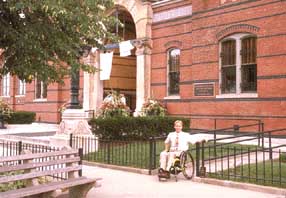
Attractive plantings and fencing that minimize visibility of access ramp to large-scale historic building. |
It
is often necessary to make modifications to a historic building
so that it will be in compliance with current accessibility code requirements.
Accessibility to certain historic structures is required by three
specific federal laws: the Architectural Barriers Act of 1968, Section
504 of the Rehabilitation Act of 1973, and the Americans with Disabilities
Act of 1990. Federal rules, regulations, and standards have been
developed which provide guidance on how to accomplish access in
historic areas for people with disabilities.
Work must be carefully planned and undertaken so it does not result in the loss of character-defining spaces, features, and finishes. The goal is to provide the highest level of access with the lowest level of impact.
Note: Although the work in this section is quite often an important aspect of rehabilitation projects, it is usually not part of the overall process of preserving character-defining features (identify, protect, repair, replace); rather, such work is assessed for its potential negative impact on the building's historic character. For this reason, particular care must be taken not to obscure, radically change, damage, or destroy character-defining features in the process of rehabilitation work to meet accessibility requirements.
|
|
Considerations
|
....Accessibility
|
 |
Identify,
retain and preserve
|
recommended.....
|

|
| |
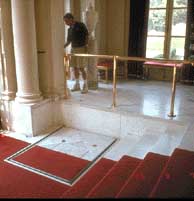
Compatible lift for historic foyer using "like" materials. |
Identifying
the historic building's character defining spaces, features, and
finishes so that accessibility code-required work will not result
in their damage or loss.
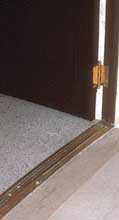
Historic threhold made accessible with 1/2" wood bevel. |
Complying
with barrier-free access requirements, in such a manner that character-defining
spaces, features, and finishes are preserved.
Working
with local disability groups, access specialists, and historic preservation
specialists to determine the most appropriate solution to access
problems.
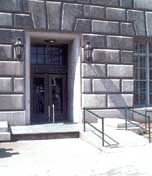
Entrance made accessible by adding inconspicuous ramp. |
Providing
barrier-free access that promotes independence for the disabled
person to the highest degree practicable, while preserving significant
historic features.
Designing new or additional means of access that are compatible with the historic building and its setting.
|
|
not
recommended.....
|

|
| |
Undertaking
code-required alteration before identifying those spaces, features,
or finishes which are character-defining and must therefore be preserved.
Altering,
damaging, or destroying character-defining features in attempting
to comply with accessibility requirements.
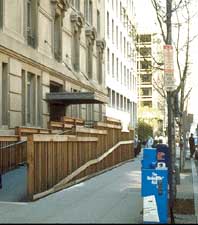
Large wood ramp incompatible with building's historic character. |
Making
changes to buildings without first seeking expert advice from access
specialists and historic preservationists, to determine solutions.
Making
access modifications that do not provide a reasonable balance between
independent, safe access and preservation of historic features.
Designing new or additional means of access without
considering the impact on the historic property and its setting.
|
|

